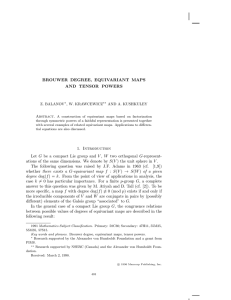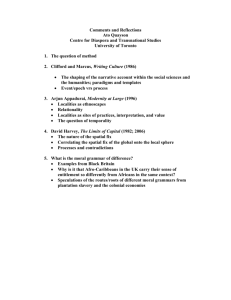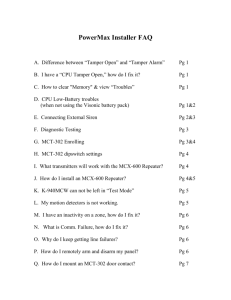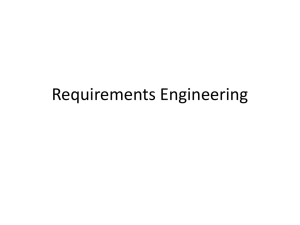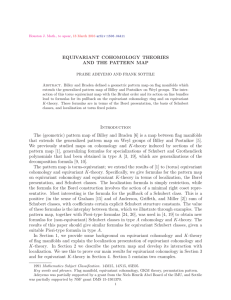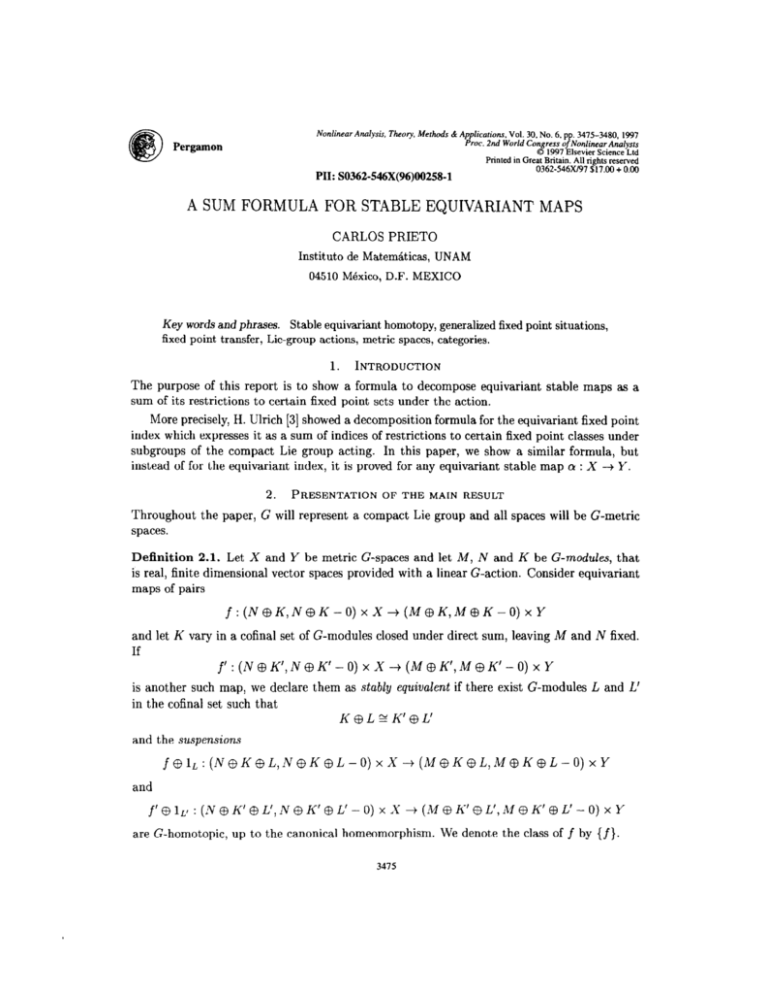
Nonlinear
Analysis,
Theory.
Methods
&Applications.
Vol. 30, No. 6, pp. 3475-3480.
1997
Proc. 2nd World Congress
ofNonlinear Analysts
Q 1997 Elsevier Science Ltd
Printed in Great Britain. All rights reserved
0362-546X/97
$17.00 + 0.00
Pergamon
PII: SO362-546X(96)00258-1
A SUM FORMULA
FOR STABLE EQUIVARIANT
MAPS
CARLOS PRIETO
Instituto de Matemkticas, UNAM
04510 MCxico, D.F. MEXICO
Key words and phrases.
Stable equivariant homotopy, generalized
fixed point transfer, Lie-group actions, metric spaces,categories.
1.
fixed point situations,
INTRODUCTION
The purpose of this report is to show a formula to decompose equivariant stable maps as a
sum of its restrictions to certain fixed point sets under the action.
More precisely, H. Ulrich [3] showed a decomposition formula for the equivariant fixed point
index which expressesit as a sum of indices of restrictions to certain fixed point classesunder
subgroups of the compact Lie group acting. In this paper, we show a similar formula, but
instead of for the equivariant index, it is proved for any equivariant stable map a : X -+ Y.
2.
PRESENTATION
OF
THE
MAIN
RESULT
Throughout the paper, G will represent a compact Lie group and all spaceswill be G-metric
spaces.
Definition 2.1. Let X and Y be metric G-spaces and let M, N and K be G-modules,
that
is real, finite dimensional vector spacesprovided with a linear G-action. Consider equivariant
maps of pairs
f:(N@K,N@K-O)xX+(M@K,M$K-0)xY
and let K vary in a cofinal set of G-modules closed under direct sum, leaving M and N fixed.
If
f’:(N@K’,N@K’-O)xX+(M@K’,M$K’-0)xY
is another such map, we declare them as stably equivalent
in the cofinal set such that
K@LrK’@L’
if there exist G-modules L and L’
and the suspensions
f~lL:(N~K~L,N~K~L-O)xX+(M~KcBL,Mc33K~L-O)xY
and
f’ @ lL, : (N @ K’ @ L’, N CBK’ a+L’ - 0) x X + (M @K’ ~4L’, M @ K’ $ L’ - 0) x Y
are G-homotopic,
up to the canonical
homeomorphism.
We denote
the class of f by {f}.
3476
SecondWorld Congress of NonlinearAnalysts
The main theorem of this report
THEOREM
2.2. Let X be a G-trivial
now reads as follows.
space and let Q : X + Y be k-stable
{cl!} = ~{CP’}
where {a(“)}
: X + YcH) c Y, {a(a))
: X + Y(a
THE RO(G)-GRADED
Then
- {CP},
c Y, both stably.
In the next section, we shall settle the elements to understand
theorem, and in section 4 we sketch the proof of the result.
3.
G-map.
(see 4.1) and prove the main
CATEGORIES
In this section we shall sketch the definition of the RO(G)-graded
equivariant stable homotopy
category and the RO(G)-graded
equivariant fixed point category, as defined in [a]. This
category is equivalent to the more usual equivariant stable homotopy category defined in
terms of regular suspensions defined by smashing pointed G-spaces with G-spheres, that is,
with one-point compactifications
of G-modules.
In the previous section we already defined the equivariant stable equivalence class of a map
2.1. We show here how it fits into a category.
First of all, we shall understand under an RO(G)-graded
category, a category whose morphism sets are graded by the elements of the real representation
ring RO(G) of the compact
Lie group G and the composite of a morphism of degree p E RO(G) and a morphism of degree
0 E RO(G), if defined, has degree p+ ~7 E RO(G).
{a}
Definition
3.1. Two classes {f} : X + Y of degree [N] - [M] and {g} : Y + 2 of degree
[A] - [K] are composed as follows.
Let {f} be represented by
f:(M,M-O)xX+(N,N-0)xY
and {g} be represented
by
g:(K,K-O)xY+(L,L-0)x2.
Then the composite {g} o {f} : X -+ 2 is constructed as follows. Let P and & be G-modules
such that P $ N and & ~3 K are isomorphic. Then {g} o {f} is represented by
the composite taken up to the induced homeomorphism
between (P $ N, P @ N - 0) x Y and
= ([IV]-[M])+([L]-[Xl).
(QcHi’, Q@K-0)xY.
Th is morphism has degree [Q$L]-[P@M]
Then we have a category G-6tab*, whose morphisms are stable G-homotopy classes of G-maps.
The other category relevant for this report is the RO(G)-graded
category G-&r* built up with fixed point situations.
equivariant
fixed point
Second World
Congress
of Nonlinear
Analysts
First recall the concept of a G-Euclidean neighborhood retract over X,
metric G-space. It is, namely, a continuous G-map y : E + X such that
G-module L, a G-invariant open set U C L x X and G-maps i : E +
commuting with the projections into X, that is, projx o i = p and po r =
that r o i = idE.
3477
a G-ENRx,
for X a
there exists a (real)
U and T : Ii + E
proj x, and are such
We shall be dealing with fixed point situations according to the following definition.
Definition
3.2. A fixed point situation over X is a commutative diagram
(X3)
where p : E --+ X is a G-ENRx, M and N are G-modules, V is an invariant open subset of
N x E and f is compactly jked: that is, the coincidence set Fix(f) = {(TJ,e) E V 1f(y, e) =
(0, e)} lies properly over X, that is, the preimage of every compact set in X is compact in
Fix (f).
In order to define the category G-Sir* we need a little more. Let p = [M] - [N] E RO(G)
be given and let
NxE>V
f
*MxE
be a fixed point situation. On the other hand, take a (nonstable) map ~0: Fix(f) + Y and
consider the pair (f, cp). Two such given pairs (fo, ~7s)and (fr, cpi) are said to be homotopic if
there exists a fixed point situation over X x I.
NxE>V
F
-MxE
and a map @ : Fix(F) + Y, such that the pair (F, (a), when restricted to each bottom and
top of the cylinder X x I, yields the two given pairs. Denote the homotopy class of (f, ‘p) by
{f, q} and call it class of degreep.
Definition
3.4. The category G-Sip* is defined as follows:
Its objects are G-ENRs. If X and Y are two objects, then a morphism of degree p from
X to Y is a class
t.f, Pn) : x -+ y
of degree p, as defined above. The identity morphism is simply the classof degree 0 {id,y, id-y},
but the composition operator is delicate to define and we refer the reader to [2].
3478
SecondWorldCongress ofNonlinear Analysts
The important fact is that both categories
Theorem 3.2). In fact, we can give a functor
u : G-$ir*
which
is the identity
G-6tab”
are isomorphic
(see [2]
+ G-(Stab’
on objects and on morphisms
X
and G-sir*
it sends a class {f, ‘p} to the composite
7(f) >Fix (f)
’
,Y,
where I
denotes the equivatiant fixed point transfer of f, which is an equivariant stable
map of degree p, as defined in [l], and cp can be considered as an equivariant stable map of
degree 0. (To be more precise, since, in fact, I
: X + W, for any neighborhood W of
Fix(f):
one has to extend, by the Tietze-Gleason
Lemma, p to an equivariant map defined
over W, and then compose.)
In particular, this proves the following result.
PROPOSITION 3.5. For any stable map {cr} E G&tab [M1-[N1(X, Y) there exists a unique
class {f, ip} of degree [M] - [N], where f : V + M x E is a fixed point situation over X and
‘p : Fix (f) -+ Y is an equivariant nonstable map, such that {a} factors as
(01 = cp O T(f).
This result has as a consequence that several properties of the transfer
more general stable maps. This is what we shall apply in the next section.
4.
PROOF OFTHE
We shall prove the main theorem
definitions.
2.2 in what
Definition
4.1. Let Y be any G-space,
class. We use the following notations.
YH
YE
YH
=
=
=
{~EYIG,>H},
{YEYIG&H},
{y E Y 1 G, = H},
can be shown for
MAIN THEOREM
follows.
First
of all, let us consider
H c G a closed subgroup
YcH)
I’(~
%)
=
=
=
some
and (H) its conjugation
{Y E Y I (Gy) 3 (H)),
{Y E Y 1 (Gy) 2 (H)},
{Y E Y I (Gy) = (fJ)I >
where G, is the isotropy group of the point y and (H) c (K) means H is contained in some
For equivariant maps
conjugate of K. Therefore YH = YH - Ya and Y(H) = Y cH) - Y(u.
restrictions.
f : X -+ Y, the maps f H, f”, fcH) and f(m are the corresponding
Theorem 2.13 in [I] is the natural
as follows.
model for the important
lemma to our proof.
It reads
THEOREM 4.2. Let E + X be a G-ENRx
with X a G-space with trivial action and Jet
V c lP x E be open and invariant.
Let, moreover, f : V -+ @Cmx E be compactly fixed.
Then the equivariant fixed point index off decomposes as follows.
I(f) = C(I(f’“‘)
- r(f’q)
E h;-“(X),
the sum taken over the finitely many orbit types around Fix(f),
G-cohomology
theory.
(4.3)
where h& is an RO(G)-graded
SecondWorld Congressof NonlinearAnalysts
Our lemma, which extends 4.2, is the following
3479
(cf. 4.2 in [2]).
LEMMA 4.4. Let E -+ X be a G-ENRx
with X a G-space with trivial action and Jet V c
IP x E be open and invariant. Let, moreover, f : V + IF” x E be compactly fixed. Then the
equivariant transfer off decomposes as follows.
T(f) = C(T(f’“‘)
-T(p))
: h’(W) + h&+*-“(X),
(4.5)
for W an invariant neighborhood of Fix(f) in Iw” x E, the sum taken over the finitely many
orbit types around Fix (f), where hG is any RO(G)-graded
G-cohomology theory. In particular,
the decomposition formula holds for the transfer r(f) seen as a stable map X -+ Fix (f): and
the sum is taken in G-(Stab”-“(X,
Fix (f)).
Now our proposition
Proof:
Decompose
3.5 can be applied to prove the desired result 2.2.
{cy} as cp o I.
By the last lemma,
df) = ~W’“‘)
- Qq).
Therefore,
P O dfj
= Jgcp O dP’)
- cp O w9
hence
{a}
= ~{a(@}
where {a W)} : x + y(H) c Y, {ay’~}
through Fix(fcH))
c Fix(f)
and #a)
- {da}),
: x + Y(ti C Y, since ~(j(“))
: X -+ Fix (f) factors through
cp)
cp
$00 T(p)
cp 0 .(pJ)
=
=
{&f’}
=
(p)
0 T(f’“‘)
: x -+ YCH) c Y,
{&a)
=
(p
07(p)
: x + Y(y)
c Y.
and let {a}
be as before.
Let X = *, Y = SL, where L is a G-module
corollary of the main theorem is the next,.
COROLLARY
4.6. {a}
: X + Fix(f) factors
Fix (f(a) c Fix (f);
= C({d”)}
This shows a decomposition
groups of G-spheres.
- {da))))
0 T(p)),
0 7(pq;
E G-6tabk(*,
An interesting
S”) = 7&(S,“)
formula for elements in the G-equivariant
stable homotopy
3480
Second World
Congress
of Nonlinear
Analysts
REFERENCES
1. C. PRIETO & H. ULRICH, Equivariant fixed point index and fixed point transfer in nonzero
dimensions, lPransactions of the Amer. Math. Sot. 328, 731-745(1991)
2. C. PRIETO, Transfers generate the equivariant stable homotopy category, Topology and its
Appl. 58, 181-191(1994)
3. H. ULRICH, “Fixed Point Theory of Parametrized Equivariant Maps”, Lect. Notes in Math.
1343, Springer-Verlag Berlin Heidelberg 1988
e-mail: cprieto@math.unam.mx


